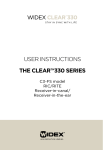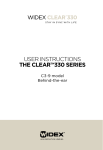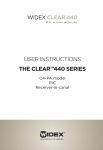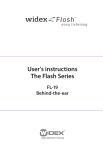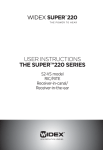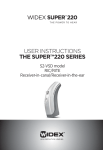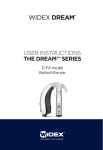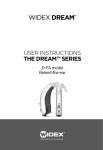Download Widex CLEAR C2-9 User manual
Transcript
USER INSTRUCTIONS THE CLEAR™220 SERIES C2-9 model Behind-the-ear YOUR WIDEX CLEAR™220 HEARING AID (To be filled out by the hearing care professional) Date: _____________________________________ Battery size: _______________________________ 2 CONTENTS SYMBOLS. . . . . . . . . . . . . . . . . . . . . . . . . . . . . . . . . . . . . . . . 4 THE HEARING AID . . . . . . . . . . . . . . . . . . . . . . . . . . . . . . . . 5 Right/left identification . . . . . . . . . . . . . . . . . . . . . . . . . . . . 9 Acoustic indicators . . . . . . . . . . . . . . . . . . . . . . . . . . . . . . . . 9 The battery . . . . . . . . . . . . . . . . . . . . . . . . . . . . . . . . . . . . . .10 Inserting the battery . . . . . . . . . . . . . . . . . . . . . . . . . . . .10 Low battery indication . . . . . . . . . . . . . . . . . . . . . . . . . .12 Turning the hearing aid on and off. . . . . . . . . . . . . . . . . .13 Volume adjustment . . . . . . . . . . . . . . . . . . . . . . . . . . . . . . .14 Listening programs . . . . . . . . . . . . . . . . . . . . . . . . . . . . . . .16 Switching between the listening programs . . . . . . . .20 Zen+ * . . . . . . . . . . . . . . . . . . . . . . . . . . . . . . . . . . . . . . . .20 Using a telephone . . . . . . . . . . . . . . . . . . . . . . . . . . . . . . . .21 Positioning the hearing aid in the ear . . . . . . . . . . . . . . .22 Removing the hearing aid . . . . . . . . . . . . . . . . . . . . . . . . .23 CLEANING . . . . . . . . . . . . . . . . . . . . . . . . . . . . . . . . . . . . . . 24 ACCESSORIES. . . . . . . . . . . . . . . . . . . . . . . . . . . . . . . . . . . 26 IN CASE OF MALFUNCTION . . . . . . . . . . . . . . . . . . . . . . . 30 CARING FOR YOUR HEARING AID. . . . . . . . . . . . . . . . . . 32 WARNINGS . . . . . . . . . . . . . . . . . . . . . . . . . . . . . . . . . . . . . 33 ADVICE . . . . . . . . . . . . . . . . . . . . . . . . . . . . . . . . . . . . . . . . 36 REGULATORY INFORMATION . . . . . . . . . . . . . . . . . . . . . . 37 3 SYMBOLS The following symbols will be used throughout the manual: WARNING Messages with this heading indicate serious adverse reactions, potential safety hazards and inadequate performance of device. CAUTION Messages with this heading indicate/include information regarding any special care to be exercised. Not for general waste. 4 THE HEARING AID The illustration below shows the hearing aid without the ear-set. 1. 2. 3. 4. 5. Microphone openings Volume control (optional) Program button On/off switch Battery drawer with nail grip 1 2 3 4 5 5 NOTE In addition to these user instructions, a separate user manual is provided describing the various ear-set solutions available for your hearing aid: “Ear-sets for Widex BTE hearing aids” WARNING This booklet and the manual “Ear-sets for Widex BTE hearing aids” contain important information and instructions. Read these booklets carefully before you start using the hearing aid. NOTE Your hearing aid, ear-set and accessories may not look exactly as illustrated in this booklet. We also reserve the right to make any changes considered necessary. 6 Intended use The CLEAR hearing aids are intended as air conduction amplification devices to be used in everyday listening environments. The CLEAR hearing aids may be provided with the Zen program intended to provide a relaxing sound background (i.e. music/noise source) for adults who desire to listen to such a background in quiet. Indications for use The devices are indicated for individuals with a full range of hearing loss severity from minimal (10 dB HL) to severe (90 dB HL) and all hearing loss configurations. They are to be prescribed by licensed hearing healthcare professionals (audiologists, hearing aid specialists, otolaryngologists) who are trained in hearing (re)habilitation as well as tinnitus management. Description of device Your CLEAR™ hearing aid is used with an ear-set which consists of a tube and an earpiece. The hearing aid uses a proprietary wireless technology, WidexLink, to enable communication between the left and the right hearing aids, as well as between the hearing aids and the DEX accessories. 7 Your hearing aid may be provided with an optional listening program called Zen. It makes musical tones (and sometimes a rushing noise) in the background. These sounds are shaped according to your hearing loss. 8 Right/left identification The arrow shows the position of the identification mark (red mark = right and blue mark = left). Acoustic indicators The hearing aid may be set to produce a signal to indicate the use of certain functions. The signal may be a spoken message or tones adjusted by the hearing care professional in consultation with you. The signal can also be deactivated. Adjusting volume Tone* Off Confirming program button use Clicking sound Off Changing program Message Tones Off Starting up the hearing aid Message Tone Off Warning about low battery Message 4 tones Off Service reminder Message * Bold indicates standard setting 9 Off The battery We recommend zinc-air batteries. Use a size 13 battery for the hearing aid. To obtain replacement batteries, please consult your hearing care professional. It is important to take note of the expiry date and the recommendations regarding disposal of used batteries on the battery pack. Inserting the battery Before inserting a new battery into the hearing aid, remember to remove the adhesive tab. Once the tab has been removed, the battery will start functioning after a few seconds. CAUTION Do not use batteries if there is a sticky residue from the tab or other unwanted substance, as this can cause the hearing aid to malfunction. Use the nail grip to gently swing the battery drawer open. 10 Place the battery in the drawer, so that the plus (+) sign on the battery faces upward. You can use the battery magnet provided to steer the battery into place. If the battery drawer does not close easily, the battery is incorrectly inserted. When changing battery, it is a good idea to hold the hearing aid over a table. The hearing aid may be provided with a special battery drawer, helping to secure the battery in the drawer. This type of drawer can be a good choice if the hearing aid is worn by a child. 11 Low battery indication An acoustic indicator will sound when the battery is nearly exhausted, unless this function has been disabled (see page 9). We recommend that you always have a spare battery with you. WARNING Never leave an exhausted battery in the hearing aid. Exhausted batteries may leak, damaging the hearing aid. WARNING Your hearing aid may stop functioning, for instance if the battery is exhausted. You should be aware of this possibility, in particular when you are in traffic or are otherwise dependent on warning signals. 12 Turning the hearing aid on and off The battery drawer of the hearing aid also functions as the on/off switch. Push the switch upwards to turn on the hearing aid. An acoustic indicator will indicate that the hearing aid has been switched on unless this function has been disabled. Push the switch downwards to turn off the hearing aid. The word “OFF” is clearly visible on the switch when the hearing aid is turned off. OFF Please remember to turn off the hearing aid when it is not in use. Remove the battery if the hearing aid will not be used for several days. 13 Volume adjustment The hearing aid volume is adjusted automatically in accordance with your sound environment. Your hearing aid may furthermore be provided with a volume control, shaped like a small lever. Push the lever upward to gradually raise the volume. Push the lever downwards to gradually lower the volume. In the default setting, any volume adjustment will affect both hearing aids. For any adjustment of the steps in which volume increases or decreases, consult your hearing care professional. Each time you operate the volume control, you will hear a beep-tone unless this function has been disabled. When the maximum or minimum adjustment level is reached, a steady tone will sound. 14 To turn off the sound completely • Keep pressing the volume control lever downwards after the steady tone has sounded To turn the sound on again • Press the lever upwards or • Change listening program or • Turn the hearing aid off and turn it on again. Any adjustment of the volume setting will be cancelled when your hearing aid is turned off, or when you change program. If you wish to have the volume control disabled, please consult your hearing care professional. CAUTION If the volume in the hearing aid is generally too loud or too weak, or the reproduced sounds are distorted, or if you would like any further information, consult your hearing care professional. To mute the hearing aid with a remote control: Keep pressing the volume down key on the remote control after the long beep-tone has sounded and until it stops. Pressing one of the volume keys briefly will bring back the sound. 15 Listening programs In addition to the default Master program, your hearing aid may be provided with two of the following programs, plus the optional Zen program called Zen+. 16 Music For listening to music TV For listening to the TV Comfort Attenuates background noise Reverse focus Focus on sounds from behind Audibility Extender Makes high-frequency sounds audible Phone For listening to the telephone T In this program you listen via the telecoil (T) and not via the hearing aid microphone (M). The telecoil is used where a loop system is installed. If you activate the telecoil program, you listen to a specific sound source and shut out surrounding sounds. M+T In this program you listen via the hearing aid microphone (M) and the telecoil (T). Zen (optional) Generates different kinds of tones. Contains one style Compound programs The Master program in one ear and Zen, Reverse focus, Audibility Extender, T, MT or Phone in the other. Zen+ (optional) Special Zen program with up to three different Zen styles 17 If your needs change over time, the combination of listening programs can be altered. The optional Zen program may be used with amplification so that both the surrounding sounds and the Zen tones are heard together. Or, it may be used alone (without amplification) in quiet when you are not required to hear surrounding sounds. The duration of the Zen play time can be set by your hearing care professional according to your needs. Benefits The Zen program may provide a relaxing listening background for some people. When the Zen program is used in a tinnitus management program, its wearer may experience some relief from tinnitus. 18 CAUTION Use of the different Zen programs may interfere with hearing surrounding sounds including speech. The programs should not be used when hearing such sounds is important. Switch the hearing aid to a non-Zen program in those situations. CAUTION If you perceive decrease in loudness, tolerance of sounds, speech not as clear, or worsening tinnitus, contact your hearing care professional. 19 Switching between the listening programs Each time you switch to another program, an acoustic indicator will sound unless this function has been disabled. Program 1: Program 2: Program 3: Zen+ *: Message or one short beep Message or two short beeps Message or three short beeps Message or tone In the default setting, both your hearing aids will be affected when you change programs. Zen+ * This program is accessed via a long press (two secs.) on the program button on the hearing aid or the RC-DEX. A short press then allows you to cycle through the available Zen styles. You can exit Zen+ by pressing and holding the program button for two seconds. * optional 20 Using a telephone When using a telephone, we recommend that you hold the telephone against your head at an angle above your ear, rather than directly against the ear. If the sound is not optimal, try moving the telephone earpiece to a slightly different position. 21 Positioning the hearing aid in the ear Insert the earmould in the ear canal while holding the lower part of the tubing. It may help to pull the outer ear backwards and upwards with the opposite hand. Place the hearing aid behind the ear, so that the earhook rests comfortably on the ear, close to your head. The illustrations show a classic earmould. For further information on ear-tip/earmould types, anchors and procedures, see the separate ear-set user manual provided. 22 Removing the hearing aid Remove the hearing aid from its position behind the ear. Carefully pull the earmould out of the ear canal, while holding the lower part of the tubing. 23 CLEANING The following cleaning accessories are available for the hearing aid and ear-set.* Please see user manual “Earsets for Widex BTE hearing aids”. 1. Cloth 2. Wax removing tool 3. Cleaning thread Contact your hearing care professional if you need additional supplies of cleaning accessories. * Selection depends on ear-set type. 24 Clean the hearing aid with the soft cloth after use. WARNING Never use water or cleaning solutions to clean the hearing aid, as this may cause it to malfunction. When the hearing aid is not in use, the battery drawer should be left open, to ventilate the hearing aid and allow it to dry. 25 ACCESSORIES A variety of assistive listening devices are available for your hearing aid. • RC-DEX • TV-DEX • M-DEX For help in determining whether you could benefit from a remote control or other accessories, please consult your hearing care professional. 26 Audio input The hearing aid can be furnished with an audio shoe. This allows direct connection to different kinds of accessories (FM and CROS/Bi-CROS systems), as well as external audio equipment (radio, TV, etc.). In this way the sound from, for example, a radio or someone provided with an FM microphone can be sent directly into the hearing aid. In the standard setting, the hearing aid automatically switches to an audio program when an audio shoe is attached. If you then wish to switch to one of the other programs, you must use the program button on the hearing aid. As soon as you remove the audio shoe, the usual program order is re-established. On the form on the next page, your hearing care professional can make a note of the audio programs you have access to and where they are located. 27 For more information on the use of audio input consult your hearing care professional. Program Program order with audio shoe 1 2 3 CAUTION If the hearing aid is connected to equipment which is connected to the electrical mains, this equipment must meet the safety requirements stated in the international standard IEC 60065. Do not connect the hearing aid to sockets that are labelled with one or more of the following symbols: 28 FM systems An FM system is an assistive listening device that can be used as an accessory for the hearing aid. The FM system from Widex is called SCOLA. The FM system consists of a wireless microphone and a receiver clicked onto the hearing aid via an FM shoe. The SCOLA FM system can be set according to your needs. This may mean that the hearing aid program button will work differently than when using an audio shoe. For help in determining whether you could benefit from an FM system, please consult your hearing care professional. 29 IN CASE OF MALFUNCTION Problem Possible cause Solution The hearing aid is completely silent The hearing aid is not turned on Make sure the battery drawer is pushed all the way upwards The battery does not work Insert a new battery in the hearing aid The hearing aid volume is not powerful enough The battery is nearly exhausted Insert a new battery in the hearing aid Your ear is blocked by earwax Contact your ENT doctor/physician Your hearing may have changed Contact your hearing care professional Your ear is blocked by earwax Contact your ENT doctor/physician The tubing is yellow, stiff or broken Replace the tubing The earmould/eartip is not correctly placed in your ear canal Take the earmould/ ear-tip out and reinsert it The earmould/eartip fit is too loose Contact your hearing care professional The on/off switch is dirty Push the switch back and forth a couple of times The hearing aid whistles continuously The hearing aid functions intermittently 30 Problem Possible cause Solution Your two hearing aids are not working in synchrony The connection between the hearing aids is lost Turn the hearing aids off and on again The hearing aids do not respond with a corresponding change in volume or program to the RC-DEX a. The RC-DEX is used beyond the transmission range (> 1 m) b. Strong electromagnetic interference in the vicinity c. The RC-DEX and the CLEAR hearing aids are not matched a. Move the RC-DEX closer to the CLEAR hearing aids b. Move away from known source of EM interference c. Check with dispenser to make sure RCDEX is matched with CLEAR hearing aids The wearer hears “interrupted” speech (on and off) from the hearing aids or no speech (muted) from the transmitting ear. a. The battery in a. Replace battery in one of the hearing one or both hearing aids has expired aids b. Strong electrob. Move away from magnetic interfeknown sources of rence in the interference vicinity 31 CARING FOR YOUR HEARING AID The hearing aid is a valuable object and should be treated with care. Here are some things you can do to prolong the life of your hearing aid: CAUTION • Turn off your hearing aid when it is not in use. Remove the battery if the hearing aid will not be used for several days. • When the hearing aid is not in use, keep it in its case in a cool, dry location out of reach of children and pets. • Do not expose the hearing aid to extreme temperatures or high humidity. Make sure to dry the hearing aid thoroughly after heavy perspiration such as that which may occur during intense physical activity, e.g. playing sports. • Avoid dropping your hearing aid – perform cleaning and battery changes while holding the hearing aid above a soft surface. • Do not wear your hearing aid while in the shower or swimming, or when using a hair dryer, perfume, hair and body sprays or gels such as suntanning lotions or creams. • In environments with high humidity, a drying kit may be used daily to reduce the amount of moisture inside the hearing aid. See the instructions enclosed with the drying kit . 32 WARNINGS WARNING Hearing aids and batteries can be dangerous if swallowed or used improperly. Swallowing or improper use can result in severe injury or even fatalities. In case of ingestion, contact a physician immediately. • Keep hearing aids and their parts, accessories and batteries out of reach of children and anyone else who might swallow such items or otherwise cause injury to themselves. Do not change batteries in front of them and do not let them see where you keep your battery supply. Discard used batteries carefully. • Batteries are very small and can easily be mistaken for pills or the like. Never put a battery or hearing aid in your mouth for any reason as you may risk swallowing it. 33 WARNING • Risk of explosion if battery is replaced by an incorrect type or recharged. Dispose of used batteries according to the instructions. • Never allow others to wear your hearing aid, as this could cause permanent damage to their hearing. • When selecting a listening program, please remember that there are situations in which it is particularly important to be able to hear the surrounding sounds (e.g. traffic, warning signals). • The hearing aid is made of modern non-allergenic materials. Nonetheless, in rare cases skin irritation may occur. If you notice skin irritation in or around your ear or ear canal, contact your hearing care professional. WARNING • Be aware that the use of any type of hearing aid may involve a slightly increased risk of infection in the ear canal. An infection can arise as a result of inadequate ventilation of the ear. We therefore recommend that you remove the hearing aid and ear-set from your ear at night to allow the ear canal to be ventilated. Make sure that you clean and inspect your hearing aid and ear-set as required. If an infection occurs, you should seek medical attention and contact your hearing care professional for advice on how to disinfect the various hearing aid parts. Do not under any circumstances use alcohol, chlorine or similar substances. • Widex hearing aids are not certified for use in mines or other areas with explosive gases. 34 WARNING • Do not wear your hearing aid during radiation, X-rays, MRIs, CT or other medical treatments and scans. The emissions from these procedures as well as from other types of radiation, such as that in a microwave oven, can damage your hearing aid. Radiation from, for example, room surveillance equipment, burglar alarms and mobile phones is weaker and will not damage the hearing aid but may create audible interference. CAUTION • Your hearing aid has been tested for interference according to international standards. Nevertheless, it is possible that unforeseen interference may occur in the hearing aid due to electromagnetic radiation from other products such as alarm systems, room surveillance equipment and mobile phones. • Although your hearing aid has been designed to comply with the most stringent international electromagnetic compatibility standards, the possibility cannot be excluded that it may cause interference with other equipment, such as medical devices. • Never try to open or repair the hearing aid yourself. 35 ADVICE NOTE • The hearing aid will not restore normal hearing and will not prevent or improve a hearing loss resulting from organic conditions. However, the hearing aid can help you to make the best possible use of your remaining hearing ability. You should also bear in mind that it can take time to get used to a new hearing aid and new sounds. • In most cases, using the hearing aid infrequently will not permit you to gain full benefit from it. • The use of a hearing aid is only part of hearing habilitation and may need to be supplemented by auditory training and instruction in lipreading. • The use of hearing aids increases the risk of accumulation of earwax. Contact your physician/ENT doctor if you suspect that a plug of earwax has accumulated in your ear. Earwax may not only reduce your own hearing but also the effect of the hearing aid considerably. It is a good idea to ask your physician to clean your ears a couple of times a year. 36 REGULATORY INFORMATION Federal Communications Commission and Industry Canada Statement FCC ID: TTY-C49 IC: 5676B-C49 This device complies with part 15 of the FCC Rules and with RSS-210 of Industry Canada. Operation is subject to the following two conditions: (1) This device may not cause harmful interference, and (2) this device must accept any interference received, including interference that may cause undesired operation. NOTE: This equipment has been tested and found to comply with the limits for a Class B digital device, pursuant to part 15 of the FCC Rules. These limits are designed to provide reasonable protection against harmful interference in a residential installation. This equipment generates, uses and can radiate radio frequency energy and, if not installed and used in accordance with the instructions, may cause harmful interference to radio communications. However, there is no guarantee that interference will not occur in a particular installation. If this equipment does cause harmful interference to radio or television reception, which can be determined by turning the equipment off and on, the user is encouraged 37 to try to correct the interference by one or more of the following measures: — Reorient or relocate the receiving antenna. — Increase the separation between the equipment and receiver. — Connect the equipment into an outlet on a circuit different from that to which the receiver is connected. — Consult the dealer or an experienced radio/TV technician for help. NOTE: This equipment complies with FCC radiation exposure limits set forth for an uncontrolled environment. This transmitter must not be co-located or operating in conjunction with any other antenna or transmitter. This equipment complies with the Industry Canada RF radiation exposure limits set forth for an uncontrolled environment as per IC RSS-102. Changes or modifications to the equipment not expressly approved by Widex could void the user’s authority to operate the equipment. 38 Hereby, Widex A/S declares that this C2-9 is in compliance with the essential requirements and other relevant provisions of Directive 1999/5/EC. A copy of the Declaration of Conformity can be found at: http://www.widex.com 39 Hearing aids, accessories and batteries should not be disposed of with normal household waste. Please consult your national Widex distributor for advice on how to dispose of these items. 40 41 42 43 Manufacturer ¡9 514 0172 001w¤ ¡#01v¤ Printed by HTO / 2011-03 9 514 0172 001 #01














































